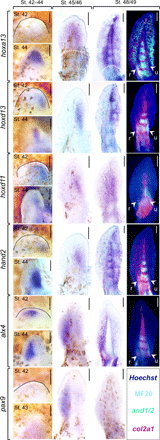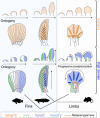Sarcopterygian fin ontogeny elucidates the origin of hands with digits
- PMID: 32875118
- PMCID: PMC7438105
- DOI: 10.1126/sciadv.abc3510
Sarcopterygian fin ontogeny elucidates the origin of hands with digits
Abstract
How the hand and digits originated from fish fins during the Devonian fin-to-limb transition remains unsolved. Controversy in this conundrum stems from the scarcity of ontogenetic data from extant lobe-finned fishes. We report the patterning of an autopod-like domain by hoxa13 during fin development of the Australian lungfish, the most closely related extant fish relative of tetrapods. Differences from tetrapod limbs include the absence of digit-specific expansion of hoxd13 and hand2 and distal limitation of alx4 and pax9, which potentially evolved through an enhanced response to shh signaling in limbs. These developmental patterns indicate that the digit program originated in postaxial fin radials and later expanded anteriorly inside of a preexisting autopod-like domain during the evolution of limbs. Our findings provide a genetic framework for the transition of fins into limbs that supports the significance of classical models proposing a bending of the tetrapod metapterygial axis.
Copyright © 2020 The Authors, some rights reserved; exclusive licensee American Association for the Advancement of Science. No claim to original U.S. Government Works. Distributed under a Creative Commons Attribution License 4.0 (CC BY).
Figures




References
-
- Woltering J. M., Duboule D., The origin of digits: Expression patterns versus regulatory mechanisms. Dev. Cell 18, 526–532 (2010). - PubMed
-
- Wagner G. P., Chiu C. H., The tetrapod limb: A hypothesis on its origin. J. Exp. Zool. 291, 226–240 (2001). - PubMed
-
- Westoll T. S., The origin of the primitive tetrapod limb. Proc. R. Soc. Lond. Series B Biol. Sci. 131, 373–393 (1943).
-
- Gregory W., Raven H., PartIII: On the transformation of the pectoral and pelvic paddles of Eusthenopteron type into pentadatylate limbs. Ann. New York Acad. Sci. 42, 313–327 (1941).
Publication types
LinkOut - more resources
Full Text Sources

